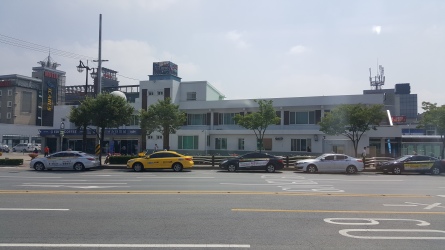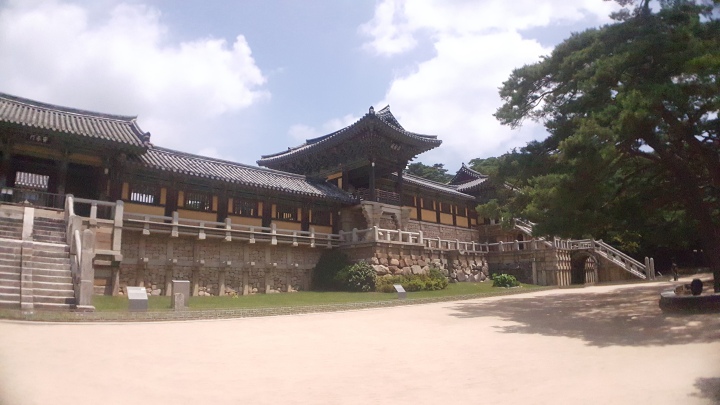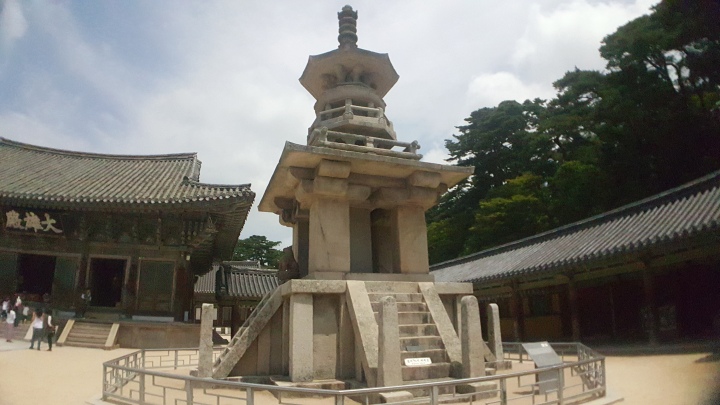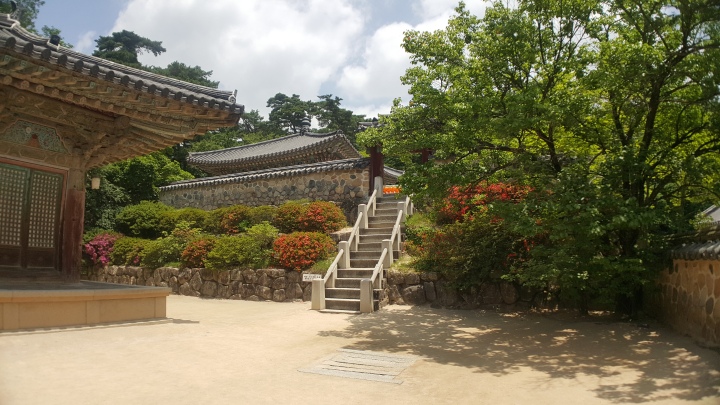Hi! Thank you for coming back to my site and I’m going to tell you about Bulguksa temple.

I started at ‘Gyeongju Intercity Bus Terminal’ stop and the bus number was 10. You can get into the bus at the opposite side stop. It takes about 30~40 minutes to get there. It will drop you at ‘Bulguksa’ stop and you can see information center at the opposite side. Cross the road to there and find a red sign like below image. There are two way to get Bulguksa and you can choose one of them. Both of them are leading you to the destination.
Historic information

Bulguksa is located on the slopes of mount Toham. It is a head temple of the Jogye Order of Korean Buddhism and encompasses seven National treasures of South Korea, including Dabotap and Seokgatap stone pagodas, Cheongun-gyo (Blue Cloud Bridge), and two gilt-bronze statues of Buddha. I took pictures of them but I couldn’t do is for statues of Buddha because it’s not allowed to do. The temple is classified as Historic and Scenic Site No. 1 by the South Korean government.In addition, Bulguksa was added to the UNESCO World Heritage List together with the Seokguram Grotto, which lies four kilometers to the east.
The temple is considered as a masterpiece of the golden age of Buddhist art in the Silla kingdom.
Among the earliest woodblock prints in world, a version of the Dharani sutra dated between 704 and 751 was found there in 1966. Its Buddhist text was printed on a mulberry paper scroll. The temple’s records state that a small temple was built on this site under King Beopheung in 528. The Samguk Yusa records that the current temple was constructed under King Gyeongdeok in 751, begun by Prime Minister Kim Daeseong to pacify the spirits of his parents. The building was completed in 774 by the Silla royal court, after Gim’s death, and given its current name Bulguksa (Temple of the Buddha Land).

The temple was renovated during the Goryeo Dynasty and the early Joseon Dynasty. During the Imjin wars, the wooden buildings were burned to the ground. After 1604, reconstruction and expansion of Bulguksa started, followed by about 40 renovations until 1805.
After World War II and the Korean War, a partial restoration was conducted in 1966. Upon an extensive archeological investigation, major restoration was conducted between 1969 and 1973 by the order of President Park Chung Hee, bringing Bulguksa to its current form. The famous stone structures are preserved from the original Silla construction.


I followed left one and came out through main entrance. It doesn’t matter whether you wanna enter through main or not. It took 10 or 15 minutes to get the entrance and it was really gentle. There are some vendors on the road and if you don’t have any interest in junk, do not care about it. It’s not a reasonable price so don’t buy it except emergency situation. I don’t know what can be the emergency situation lol.


Before you come in there, you should buy a ticket. Entrance fee is 5,000 won for each(4.31 USD). As entrance fee of culture asset in Korea, it’s more expensive than others but so reasonable price for this place. I swear.
Regardless of this topic, I don’t want to accept culture assets’ admission fee in Korea because it’s so cheap and almost Korean people regard it as natural. I don’t think so. It could be more expensive than now and it should be cared really well. Let’s talk about it later.
Anyway when you walk along the road, you can meet some structure. It’s one of treasures in this temple. It’s called as Cheongun-gyo (Blue Cloud Bridge) and Baegungyo (White Cloud Bridge).
Cheongun-gyo(Blue Cloud Bridge) and Baegungyo (White Cloud Bridge)



The Cheongungyo (Blue Cloud Bridge) and Baegungyo (White Cloud Bridge) Bridges of Bulguksa Temple are two bridges that are a part of a stairway that leads to the temple. The bridges were probably built in 750 during the reign of Queen Gyeongdeok.
The Blue Cloud Bridge makes up the lower span of the stair while the White Cloud Bridge is the upper part. The bridges lead to the Jahamun (Golden Purple Gate) which leads to Sakyamuni Hall. There are 33 steps on the stairway, which slopes at a 45 degree angle, and each step corresponds to one of the 33 heavens of Buddhism. The lower Blue Cloud Bridge has seventeen steps while the upper White Cloud Bridge has sixteen. The large arch underneath the stairwell testifies to the use of arches in Silla-style bridges and the remains of a pond that once flowed underneath the bridge.
Not only just the stairs, also the arch structure under the stair ways are worth noticing. I didn’t take a picture of them but when you go there, please look at it well. Even they were made in 750, their structure seems to be balanced. In addition, this kind of structure is not usual in Korean temple so it’s worthy of themselves.
When you get in there and pass another gate, you can see two pagodas. They are also treasure of Korea, and one of them can be seen at coin 10 won.
Dabotap and Seokgatap stone pagodas
The stone pagoda Dabotap(a.k.a pagoda of many treasures) is located on the right side, opposing Seokgatap on the left side. The pagoda is supposed to have been built in 751, the 10th year of the Shilla Queen Gyeongdeok. It is currently designated as National Treasure no. 20.
The 3 story pagoda stands 10.4 metres tall and was built in an ornate style not seen in other Buddhist countries. The sculpture techniques used are unique for its time and include delicate features. The pagoda is currently depicted on the obverse of the 10 won coin.
The two pagodas reflect a story in the Lotus sutra. Dabo (Prabhutaratna), a Buddha who had already achieved enlightenment, riding the Tower of Many Treasures, appeared to attest to the validity of Sakyamuni’s sermons at Vulture Peak. Dabo and Sakyamuni then sat side by side within the tower. This pagoda represents the Dabo Buddha, while the other pagoda represents Sakyamuni. Dabo represents the objective truth, while Sakyamuni represents the subjective wisdom to realize it. Dabotap is highly decorative and looks feminine, whereas Seokgatap is highly simplified and looks more masculine. The sophisticated Dabotap symbolizes the complexity of the world; the simple Seokgatap represents the brevity of spiritual ascent. (from Fascinating Tales of Blooming Silla by Alexander Chang and Andrew Chang, 2006).
Luckily, I can meet Seokgatap when I visit there. It was disassembled for several years so I couldn’t see it recently. It has just opened and my friend Jade could see it(Hi Jade haha).



Those things are well known in Bulguksa and you can find any information about it online. Also there are commentators at there and their English skill is really awesome so if you wanna know about it well, visit information center and request that service. I highly recommend it.
Naturally, you can feel without any subscription or any comment. You know. Just feel by the way you want. (It’s my style.) It would be good way to enjoy the place seeing the structure of old building in Korea and Buddhism. The arts are so sensitive and splendid-under the roofs, doors, walls and also insides of every hall. Their harmonies are really nice so it doesn’t look like madhouse.









I followed to front gate and came out through it. It was not first time that I visit there so it was fine for me, but if it’s really first time to visit there, just get in there through front gate. As you know, for first impression, front gate might be nice way to feel it well.


Hopefully, you will have bless from Buddha in there. ;D I wish this posting was helpful for you and if there is more tips, please tell me through anyway.
Have a nice day in Korea!
Facebook http://www.facebook.com/xdjeongwon
Instagram j.wony03

Happy I could see Seokgatap. Bulguksa is an incredible temple and I learned so much from your awesome article. Thank you 😀 (Hi Emma haha!)
LikeLike
Looks like a beautiful temple. If I ever get to Korea (I hope to) I will pay it a visit 🙂
LikeLike